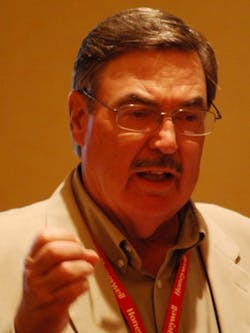In the best Socratic tradition, Richard Ortloff, senior training advisor for ExxonMobil Chemical, began with a question: "How many of you have heard someone say, 'I don't learn something until I get my hands on it'?"
The answer, of course, is "all of us at one time or another." That fact is the secret behind the use of simulation to train console operators. They get a much better idea of what they are to do, how the processes they control work and how to keep them under control when they can actually use the equipment—even in a simulated environment.
Ortloff presented "The Promise of Simulation: How to Use Experiential Learning Methods for Console Training," this week at the Honeywell Users Group Americas 2013 in Phoenix, Ariz. Simulation solutions such as Honeywell's Unisym have revolutionized operator training, but Ortloff argued that a good simulator is not enough. "Spend 25% of your time, effort and money on the training and the rest on the machine, and you will have a better result," he said. "It takes a tremendous amount of effort to build a good simulator. We don't put the same kind of care into the design of the training system. Learning needs to be designed with equal care."
Ortloff recommends leveraging the simulation technology with the techniques of experiential learning. This differs from the old model of thinking of the student as an empty vessel into which the instructor pours knowledge.
The experiential model is cyclical and can be repeated often. It begins with a concrete experience. This is what is delivered with the simulator.
"Spend 25% of your time, effort and money on the training and the rest on the machine." ExxonMobil Chemical's Richard Ortloff says industry doesn't spend enough time or effort on simulator training methodologies.
Next comes problem framing. This technique engages the learner as a problem solver and puts the problem scenario in context. It widens his or her vision to include, not just the problem itself, but the situation in which the problem exists. "Problem-based learning is a key component of a good learning experience," said Ortloff.It not only engages students, immersing them in real-world scenarios, but it encourages active decision-making. This is another crucial element in designing a good simulator-based training program, said Ortloff. "Don't tell people the decision they're supposed to make. Let them figure out the solution for themselves," he added. This is how operators learn to internalize the responses they should make in a given situation.
A good simulated learning program then allows for on-the-spot experimentation. "Let people do this. Let them play a bit," said Ortloff. "A simulator allows this. Too often simulator training activities use only multiple drills that teach programmed responses. We want people to think."
Reflection in action can come anywhere in the cycle. This is a skill that enables an operator to think about what is happening as it's happening, to reflect in the middle of the action and to ask "Is this working? If not, why not? What am I doing that's not right?"
Ortloff pointed out that a simulator can be paused in the middle of an action to encourage this kind of questioning. "It teaches people to step back and ask what's going on," he said.
After that, the cycle repeats again. "It is in this cycle that people learn. Take part of the cycle out, and they won't," said Ortloff.
"Expand the typically regimented simulator training to facilitate learning through experiential learning cycles," Ortloff recommended. "Training should include active experimentation and reflective activities."
He also recommended encouraging trainees to investigate and experiment with scenarios and problems that may not have predefined solutions; allowing plenty of time for "free play" that lets learners push the simulated unit beyond normal limits; and allowing time for self-directed learning. "Then they ask questions, and you can give answers."
About the Author
Nancy Bartels
Nancy Bartels

Leaders relevant to this article:



